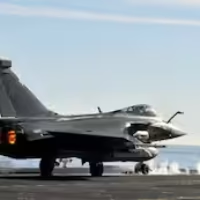The ongoing Iran-Israel conflict has entered its sixth day, intensifying with missile exchanges between the two nations. On Wednesday, Israeli forces launched a fresh wave of strikes targeting key military installations in Tehran, including the Khojir missile production facility and Imam Hossein University, both linked to Iran’s Islamic Revolutionary Guard Corps (IRGC). According to Iranian news agencies and Reuters, explosions were also heard in Tehran and Karaj, marking a sharp escalation in the hostilities.

The Israel Defense Forces (IDF) confirmed that over 50 Israeli fighter jets carried out a series of intelligence-driven airstrikes on Tehran’s military sites. The strikes came shortly after Iran launched retaliatory missiles, triggering multiple air raid sirens across Israel, particularly in the north due to UAV intrusions. The IDF also stated that two unmanned aerial vehicles (UAVs) were intercepted after crossing into Israeli territory from the east.
Meanwhile, the United States is stepping up its involvement in the Middle East conflict. President Donald Trump, after demanding Iran’s unconditional surrender, warned Tehran against further escalation, stating the U.S. has “total control of the skies over Iran.” Although the U.S. has not conducted direct strikes, military reinforcements including fighter jets are being deployed to the region. Trump also revealed they know the location of Supreme Leader Ayatollah Ali Khamenei, but claimed the U.S. will “not kill him—at least for now.”
The conflict erupted following Israel’s surprise offensive, dubbed “Operation Rising Lion,” which targeted Iran’s nuclear and military infrastructure last Friday. The operation has resulted in the deaths of several high-ranking IRGC commanders, creating a strategic void around Khamenei. Iran has reported at least 224 deaths, while Israel has confirmed 24 civilian casualties. With G7 leaders and the U.S. aligned against Iran’s nuclear ambitions, the Middle East is bracing for what may become a wider regional war.













